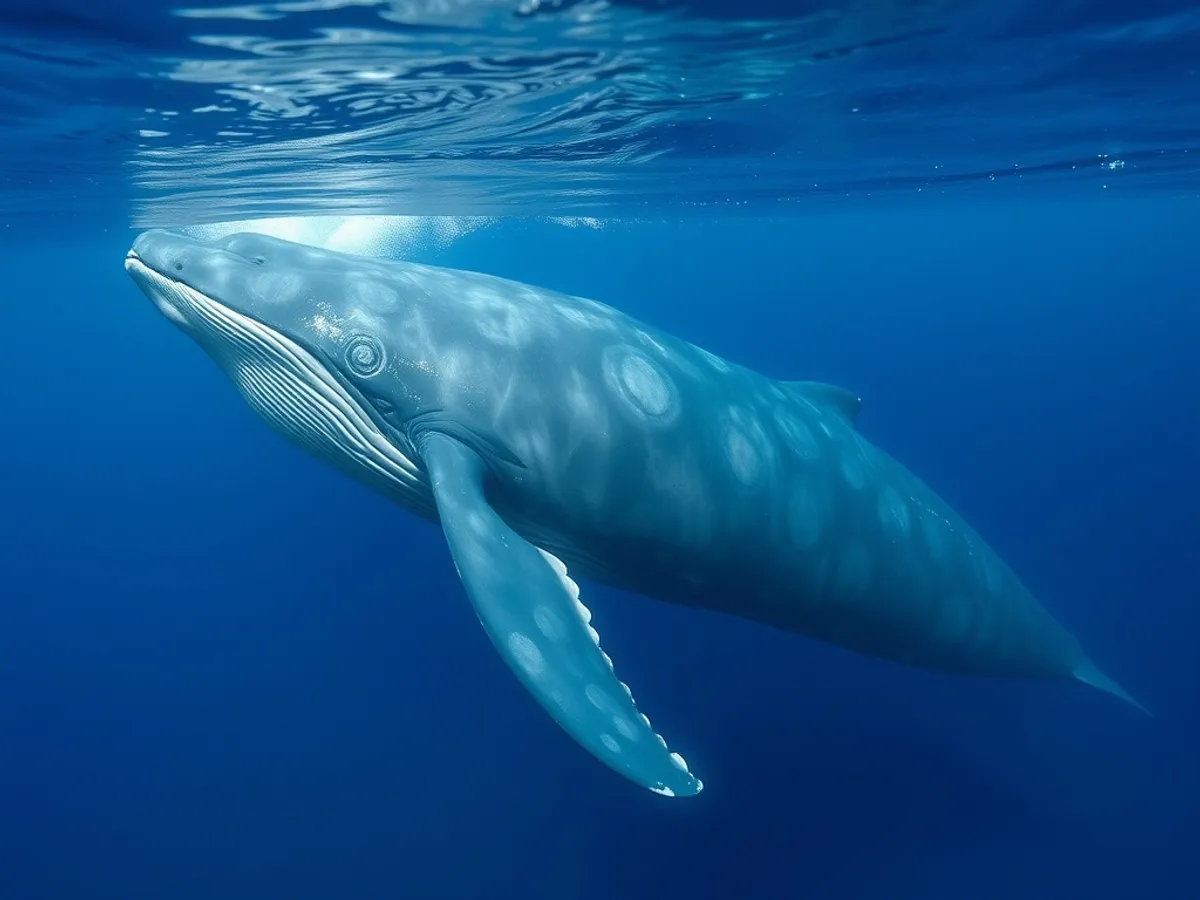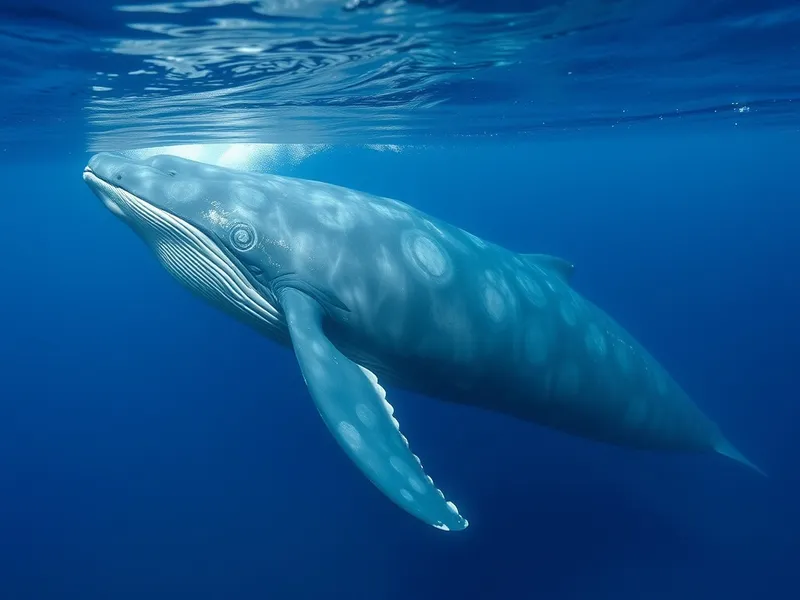
Blue Whale
Balaenoptera musculus

Meet the Blue Whale
The blue whale is the largest animal known to have ever existed, reaching lengths of up to 30 meters (98 feet) and weighing as much as 180 metric tons. Its long, slender body is bluish-grey with lighter spots, and it is equipped with a massive mouth that contains baleen plates for filter-feeding. Blue whales are found in all the world's oceans except the Arctic, typically migrating between feeding and breeding grounds. These gentle giants feed primarily on tiny shrimp-like creatures called krill, consuming up to 4 tons per day during peak feeding season. Despite their immense size and power, blue whales are vulnerable to various threats, and their populations remain endangered.
Classification
Mammal
Habitat
Open ocean (pelagic zone)
Diet
Carnivore
Lifespan
70-90 years
Conservation
Endangered
Weight
100,000–180,000 kg
📖Fascinating Facts
Record-Breaking Size
Blue whales are the largest animals ever known, even bigger than the largest dinosaurs, with some individuals measuring nearly 30 meters (98 feet) long.
Loudest Animal
The blue whale's vocalizations are among the loudest of any animal, reaching up to 188 decibels, which can travel vast distances across ocean basins.
Krill Feast
During feeding season, a blue whale can consume up to 4 tons of krill per day, using its baleen plates to efficiently filter massive amounts of food from the water.
📋Detailed Description
The blue whale (Balaenoptera musculus) is a colossal baleen whale and the largest animal ever known, with adults typically measuring 24–29.9 meters (79–98 feet) in length and weighing between 100–199 metric tons. Its streamlined body is bluish-grey with mottled lighter spots, and the ventral side is paler. The head is broad and U-shaped, comprising up to a quarter of the body length, and houses a massive mouth containing 270–395 black baleen plates on each side for filter-feeding. Blue whales possess 55–68 throat pleats (ventral grooves) that expand dramatically during feeding. Their heart is the largest of any animal, weighing up to 180 kg (400 lbs), and their aorta is large enough for a human child to crawl through. Blue whales have relatively small dorsal fins set far back on the body and long, slender flippers. Their lungs can hold approximately 5,000 liters of air, allowing them to dive for up to 30 minutes, although typical dives last 10–20 minutes. Blue whales are generally solitary or found in pairs, but loose aggregations may form in rich feeding grounds. Their vocalizations are among the loudest and lowest-frequency sounds produced by any animal, traveling hundreds of kilometers underwater and possibly serving for long-distance communication or navigation.
💡 Did you know?
A single blue whale tongue can weigh as much as an elephant.
🔬Research & Sources
Wikipedia Summary
The blue whale is a marine mammal and a baleen whale. Reaching a maximum confirmed length of 29.9 m (98 ft) and weighing up to 199 t, it is the largest animal known ever to have existed. The blue whale's long and slender body can be of various shades of greyish-blue on its upper surface and somewhat lighter underneath. Four subspecies are recognized: B. m. musculus in the North Atlantic and North Pacific, B. m. intermedia in the Southern Ocean, B. m. brevicauda in the Indian Ocean and South Pacific Ocean, and B. m. indica in the Northern Indian Ocean. There is a population in the waters off Chile that may constitute a fifth subspecies.
Last Modified: 5/28/2025
🎭Behavior & Social Structure
Blue whales are primarily solitary, though pairs—often mother and calf or temporary feeding associations—are occasionally observed. They exhibit seasonal migrations, traveling thousands of kilometers between high-latitude summer feeding grounds and low-latitude winter breeding areas. Feeding behavior is characterized by lunge-feeding: the whale accelerates toward dense krill swarms, opens its mouth, and engulfs vast volumes of water and prey, then closes its mouth and uses its tongue to force water out through the baleen plates, trapping krill. An adult blue whale may consume up to 40 million krill per day during peak feeding season. Blue whales are generally slow swimmers (3–8 km/h), but can reach speeds of over 20 km/h in short bursts. They communicate using infrasonic vocalizations (10–40 Hz), which are believed to play a role in mate attraction and navigation. Social interactions are limited outside of mother-calf pairs, but temporary associations may occur in areas of high prey density.
👶Reproduction & Life Cycle
Blue whales reach sexual maturity at 8–10 years of age, typically when they are 21–23 meters long. Mating and calving generally occur during the winter months in warmer, lower-latitude waters. Females give birth to a single calf after a gestation period of approximately 10–12 months. Calves are born measuring 6–8 meters (20–26 feet) in length and weighing 2–3 metric tons. The mother nurses her calf for 6–7 months, during which the calf gains up to 90 kg (200 lbs) per day on her rich, high-fat milk. Calves are weaned at the onset of the next migration to feeding grounds. There is little evidence of paternal care, and intervals between births are typically 2–3 years.
🛡️Adaptations & Survival
Blue whales exhibit several remarkable adaptations for their pelagic lifestyle. Their immense size and streamlined shape reduce drag and facilitate efficient long-distance migration. The pleated throat grooves allow the mouth to expand massively during lunge-feeding, maximizing krill intake. Baleen plates enable efficient filtering of small prey from seawater. Their thick blubber layer insulates against cold ocean temperatures and stores energy for long migrations. The low-frequency vocalizations can travel across ocean basins, facilitating communication over vast distances. Their large eyes are adapted for low-light conditions at depth, and their circulatory system is specialized to withstand dramatic pressure changes during deep dives.
📚Research Sources
🎨Cultural Significance
Blue whales have captured human imagination for centuries, symbolizing the majesty and mystery of the ocean. They appear in maritime folklore, literature, and art as embodiments of size and power. In modern times, blue whales are icons of marine conservation and biodiversity. Whale-watching tourism centered on blue whales contributes to local economies and raises awareness about marine conservation. Historically, blue whale products (oil, baleen) were highly valued, but today, their protection is prioritized worldwide.
🔬Recent Research & Discoveries
Recent research has focused on blue whale vocalizations, migration patterns (using satellite tagging), and population genetics. Studies have revealed distinct regional populations and possible cryptic subspecies, such as the Chilean blue whale. Advances in acoustic monitoring have improved population estimates and tracking. Research on krill dynamics and climate change impacts is ongoing, as blue whale survival is tightly linked to prey availability. Genetic studies are clarifying subspecies boundaries and historical population bottlenecks. Conservation research is addressing ship strike mitigation and the effects of anthropogenic noise.
🎥Wildlife Videos

Titans of the Deep - The Fascinating World of Whales | Free Documentary Nature
Titans of the Deep - The Fascinating World of Whales | Ocean Documentary Watch 'Ocean Stories' here: ...
Free Documentary - Nature

Oceans Odysseys: Incredible Animal Journeys (Full Episode) | National Geographic
Jump on board with the dedicated ocean moms risking it all to bring new life into the world. Enjoy a free trial of National ...
National Geographic

Blue Whales 101 | Nat Geo Wild
#NatGeoWILD #BlueWhales #Educational About National Geographic Wild: National Geographic Wild is a place for all things ...
Nat Geo Animals

Are Whales Smarter Than We Think? | Narrated by David Attenborough | 4K Nature Documentary
Whales have long been a mystery to humans, but what if they are far more intelligent than we ever imagined? In WHALE WISDOM ...
Terra Mater

Blue Whale| Blue Whale Sounds| Blue Whale vs Shark| Blue Whale Megalodon| Animal's Guide
Animal's guide Blue Whale (Balaenoptera musculus) – The Gentle Giant of the Ocean #animalsguide #bluewhales The ...
The Natures Guide

Giants of the Seas - The Mystery of the Sperm Whales | Free Documentary Nature
Giants of the Seas - The Mystery of the Sperm Whales | Ocean Documentary Watch 'Adventure Ocean Quest: Discovering Another ...
Free Documentary - Nature
🌍Habitat Information
The Blue Whale typically inhabits Open ocean (pelagic zone) environments. Blue Whales have adapted to their environments with specialized features and behaviors.
Primary Habitat:
Open ocean (pelagic zone)
More detailed habitat information will be available soon.
🛡️Conservation Status
The Blue Whale is currently classified as Endangered. Conservation efforts are crucial for preserving this species for future generations.
Common Threats:
- 🏠Habitat loss and fragmentation
- 🌡️Climate change impacts
- 🎯Hunting and poaching
- 🏭Human-wildlife conflict
⚠️Threats & Conservation Challenges
Historically, blue whales were decimated by commercial whaling, with populations reduced by up to 97% in the 20th century. Although whaling is now banned, populations remain endangered and are slow to recover due to low reproductive rates. Current threats include ship strikes, entanglement in fishing gear, ocean noise pollution (which may interfere with communication), climate change (affecting krill abundance and distribution), and chemical pollution. Some populations, such as those in the North Atlantic and North Pacific, show signs of gradual recovery, while others remain critically low. The global population is estimated at 10,000–25,000 individuals, far below pre-whaling numbers.
🔬Scientific Classification
Scientific Name
Balaenoptera musculus
Classification Hierarchy
🔍 About Taxonomic Classification
Taxonomic classification is a hierarchical system used by scientists to classify and organize living organisms based on shared characteristics and evolutionary relationships.
The system moves from broad categories (Kingdom) to increasingly specific ones, with each animal's scientific name typically consisting of its Genus and species.
📝Community Notes
Share your observations and insights about the Blue Whale with our community of wildlife enthusiasts.
Join Our Community
Sign in to share your observations and connect with fellow wildlife enthusiasts.
Sign In to ContributeNo community notes yet
Be the first to share your observations about the Blue Whale!
Explore Blue Whale
Select a tab above to learn more about this amazing animal.
📸Photo Gallery
No photos available for this animal yet.
🌟Discover More Wildlife
Continue your journey of discovery with more fascinating animals from our database
